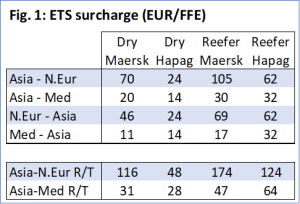As we are around three months away from the implementation of carbon taxation (ETS) in the European Union (EU) and everyone agrees that this will be a high cost, there is significant uncertainty as to the precise cost, according to Sea-Intelligence. Presently, only two carriers, Maersk and Hapag-Lloyd, have in recent weeks announced indications of these coming surcharges.
“There are many methodological problems in how to calculate the cost of ETS per container, given how the EU regulators have deemed to define the ETS, and because of challenges on how to allocate that at a per-TEU level,” say Sea-Intelligence analysts adding that “carriers are by law prevented from agreeing on a common surcharge formula, which will result in misalignment between carriers.”

The new data presented by the two European carrier powerhouses are only preliminary indications, as they will only file firm data a month prior to implementation.
“On top of that, the emissions made in 2024 will have to be accounted and paid for in September 2025. Yet to cover the cost in September 2025, the carrier will have to charge a premium, with no knowledge as to what the actual cost will be in September 2025,” explains Alan Murphy, CEO of Sea-Intelligence, a Danish maritime data analysis firm.
“It is no surprise that there are very large differences in the ETS surcharge across the two carriers,” pointed out Mr. Murphy, who went on to add that “even by looking at their relative levels, there is no pattern emerging, as for the North Europe trade, even on a roundtrip basis, Hapag-Lloyd is indicating an ETS surcharge quite a bit lower than Maersk, whereas for the Mediterranean trade, it is the reverse.”
Mr. Murphy said, “We are in no way bashing the two carriers; they should be lauded for at least providing the beginning of cost transparency of the ETS. What it illustrates is that it will be incredibly difficult for shippers to get a good overview of this upcoming ETS cost.”
(Photo from Port of Los Angeles)


